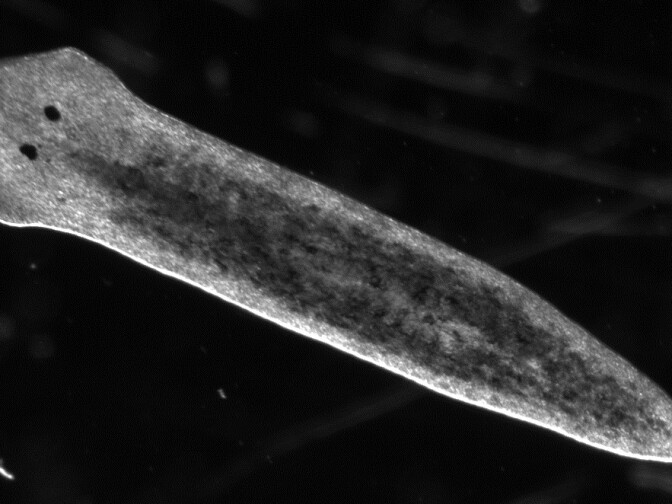With our free press under threat and federal funding for public media gone, your support matters more than ever. Help keep the LAist newsroom strong, become a monthly member or increase your support today.
Tiny worm caught in the act of reproducing — by tearing itself apart
Dugesia japonica, a tiny asexual flatworm, has an unusual way of reproducing: It tears itself in half and each section regenerates what it lost. Now a group of scientists from UC San Diego has discovered how the worm separates and the researchers say their study could eventually enhance our understanding of stem cell therapy for humans.
Dugesia japonica is found in freshwater environments in east Asia and can be from a few millimeters to a couple of centimeters long. The worm is photophobic, a favorite food of fish and likes to attach itself to rocks.
The UC San Diego team gathered a large number of the worms in a simulated environment. For over a year, they continuously recorded video, hoping to see them reproduce.
It wasn't easy. The worms only reproduce about once a month, the process only lasts for a few minutes and they're notoriously camera shy. Any hint of light or movement and their self preservation kicks in and stops the reproductive process in its tracks. And if the worms did reproduce on camera, they'd manage to find the furthermost corner of the test area for safety, obscuring the view.
But the scientists were eventually able to catch enough worms in the act to figure out how they were reproducing on their own.
The video revealed that the worms would lock their heads and tails into place, squeeze their body together creating a weak point, pulse their heads and pull, eventually separating into two parts. After a week, a new head (brain and all) would form on the tail, and a new tail on the head section.

The researchers found that where the worms split depended on where their mouths were located on their bodies, as the head would always split with the mouth. The head portion had a notably higher survival rate, an indication that the tail remained more vulnerable to predators until a head, brain and mouth had formed, said study co-author Eva-Maria Collins, an associate professor of cell and developmental biology at UC San Diego.
While the scientists' work revealed how the worms split and when, it didn't explain how they regenerate, something that Collins said her team hopes to tackle that next.
That's where stem cells come in; they make up 30 percent of the flatworm's body, and are the reason the worm can regenerate at all. In fact, they're so effective that if you cut one worm into 20 pieces, you might end up with 20 worms.
"Planarians [another term for this type of flatworm] are relatively popular as a system to understand stem cell and regenerative biology," said Collins. "Understanding better how they are able to regenerate lost body parts, the hope is of course that one day maybe we can use this knowledge to help in the development of regenerative medicine in human applications."
The study was published in the journal Proceedings of the National Academy of Sciences.










